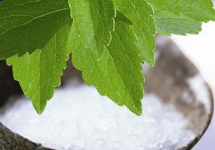 Early in November 2004 I had the opportunity to travel to Whangarei for a conference. One of the field trips was to a community garden being established by volunteers. While this is a young garden one of the plants we were introduced to was Stevia rebaudiana. I had heard about this plant many years ago and had tried to obtain it without success. And I consequently forgot about it.
Early in November 2004 I had the opportunity to travel to Whangarei for a conference. One of the field trips was to a community garden being established by volunteers. While this is a young garden one of the plants we were introduced to was Stevia rebaudiana. I had heard about this plant many years ago and had tried to obtain it without success. And I consequently forgot about it.
This discovery was amazing as at last I was able to taste the raw leaves and find out for myself how sweet the leaves of this plant really are.
Picking one leaf I bit into it and instantly my mouth was filled with a lovely sweet taste. This leaf about 3 cm long and 0.5 cm wide lasted me about 30 minutes as I continued to nibble small fragments during our tour.
Stevia is an unassuming plant and one you would walk past without giving it a second glance. It belongs to the daisy family, Compositae, and is one of about 100 species in this genus of herbs and sub shrubs. There are a number of species that have varying degrees of sweetness. This species Stevia rebaudiana is from Paraguay.
The Stevia.com website is full of information on this plant.
Dr. Moises Santiago Bertoni, director of the College of Agriculture in Asuncion, first learned of what he described as "this very strange plant" from Indian guides while exploring Paraguay's eastern forests in 1887. This area was not the herb's native 'growing ground.' Consequently, Bertoni, by his own account, was initially "unable to find it." It was 12 years before he was presented with tangible evidence — a packet of Stevia fragments and broken leaves received from a friend who had gotten them from the mate plantations in the northeast. He subsequently announced his discovery of the "new species" in a botanical journal published in Asuncion.
Bertoni named the "new" variety of the Stevia genus in honour of a Paraguayan chemist named Rebaudi who subsequently became the first to extract the plant's sweet constituent. "In placing in the mouth the smallest particle of any portion of the leaf or twig," Bertoni wrote, "one is surprised at the strange and extreme sweetness contained therein. A fragment of the leaf only a few square millimetres in size suffices to keep the mouth sweet for an hour; a few small leaves are sufficient to sweeten a strong cup of coffee or tea."
Stevia is one of the most health restoring plants on earth. What whole leaf Stevia does both inside the body and on the skin is incredible. Native to Paraguay, it is a small green plant bearing leaves which have a delicious and refreshing taste that can be 30 times sweeter than sugar. Besides the intensely sweet glycosides (Steviosides, Rebaudiosides and a Dulcoside), various studies have found the leaf to contain proteins, fibre, carbohydrates, iron, phosphorus, calcium, potassium, sodium, magnesium, zinc, rutin (a flavonoid), true vitamin A, Vitamin C and an oil which contains 53 other constituents. Quality Stevia leaves and whole leaf concentrate are nutritious, natural dietary supplements offering numerous health benefits.
Stevia is the sweetener of the future. Because the human body does not metabolize the sweet glycosides (they pass right through the normal elimination channels) from the leaf or any of its processed forms, the body obtains no calories from Stevia. Processed forms of pure Stevia can be 70-400 times sweeter than sugar. Whether these products are called Stevia, Stevioside, Rebaudioside, Stevia Extract, or Stevia Concentrate, if they are in their pure unadulterated form they do not adversely affect blood glucose levels and may be used freely by both diabetics and hypoglycemics. For people with blood sugar, blood pressure or weight problems Stevia is the most desirable sweetener.
Try the following websites for more information.
www.stevia.net
http://www.dorway.com/stevia.html
http://www.cookingwithstevia.com/
http://www.stevia-sugar-substitute.com/










rfern002 - 14 years ago
same question as before – where can I buy a plant ?